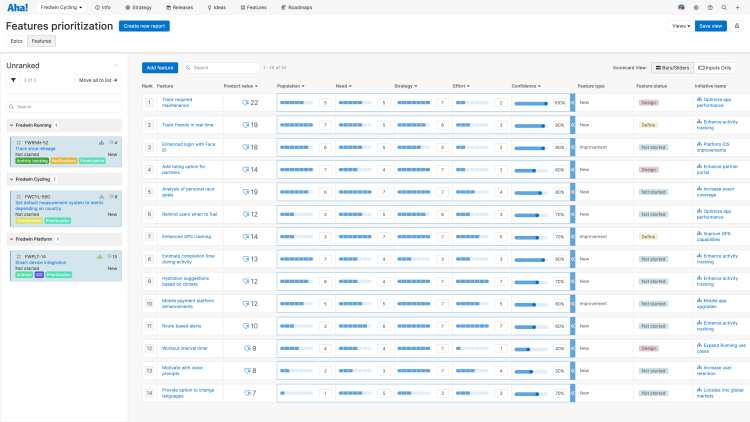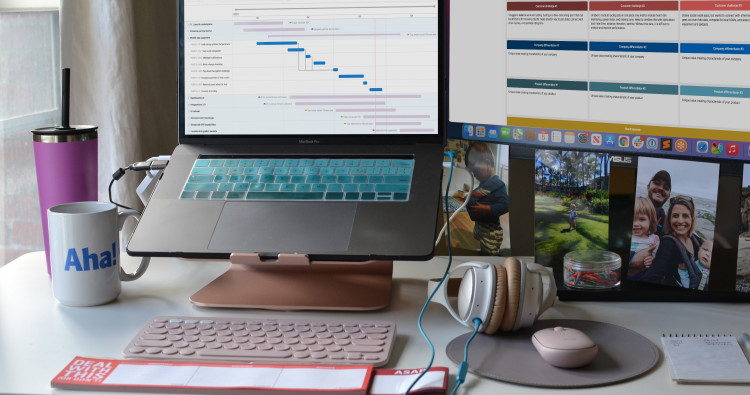
New Ways to Quickly Rank Lists of Ideas and Features
Prioritizing what to build next is challenging work. Product managers have to weigh the potential customer and business value of new functionality against the effort required to deliver the work — and then make tough trade-off decisions about where to invest. Of course, you could already use the product value scorecard to standardize the way you estimate value. But we knew there was more we could do to bring greater efficiency and collaboration to the prioritization process when you are working with large lists.
Use the new prioritization pages in Aha! Ideas and Aha! Roadmaps to swiftly adjust product value scores for ideas, epics, and features inline — then rank them in priority order for a consolidated view of what matters most.
The product value scorecard provides a consistent framework for scoring work based on population, need, strategy, effort, and confidence. This gives you an objective way to estimate the value of work and make informed prioritization decisions. But the reality is that these decisions are not made in isolation. You often need to evaluate multiple ideas or features at once and discuss their relative importance as a team. Today's update gives you a new way to do that in a single view.
Look for the new Prioritization pages in the ideas and features sections of the application. To get started, pull items from the Unranked column into the main view. You can do this individually — or filter the list by criteria such as status, tags, workspace, release, or assignee and move multiple items in bulk. Then adjust your scores inline and rank them against one another.
Better still, you can create and save as many versions of the prioritization view as you need. The rank is tied to each report rather than the actual record — giving you the flexibility to evaluate priorities through different lenses. For example, you might want to rank work based on requests from your top customers or combine items from multiple workspaces to create a unified list of priorities for shared resources.
It is important to note that these pages replace what was previously the Features List and Ideas List. If you have any saved ideas and features lists, they have now been converted into regular list reports for you — all of your settings and filters remain intact. This means you can take advantage of additional functionality, such as the ability to turn a list report into a pivot table, chart, or roadmap, and get more value out of your data.
Let's look at two ways you can use the new prioritization pages:
Quickly score incoming ideas
Streamline your idea review process. Use the prioritization page to quickly evaluate ideas that were recently submitted to your ideas portal. In the example below, we filtered by status to focus on requests that needs review and tabbed through the scorecard metrics to input values. From there, we sorted by score and can then promote the top-ranking ideas to our roadmap. It is quite a snappy way to review ideas.
Choose from bars/sliders or inputs to tab quickly through each field and adjust scores in the style you prefer
Agree on feature priorities
Let's imagine your team is prioritizing work that spans multiple products. Use filters to select the products and identify features that are not started. Seeing everything in one view makes it easy for the team to discuss the value of the work and reach consensus about which items to invest in. Below, we drag features into rank order. Now the team can move forward together.
Drag and drop or type in a rank to rapidly create your prioritized view
Keep the team organized with clear priorities — rallying everyone around the most important work.
We hope you will give these new pages a try and let us know how it goes. And if you have not used the product value scorecard yet, take a moment to check out Bonnie Trei and Erik Johnson in a recent tutorial recording. Or catch a live demo led by our product experts.
Start a free trial today
The new prioritization pages are available to all Aha! Roadmaps and Aha! Ideas customers. If you are not already an Aha! customer, you may want to sign up for a free 30-day trial or join a live demo to see why more than 600,000 product builders trust our software to build lovable products.




